Lecture notes written by Albert Jacka VC
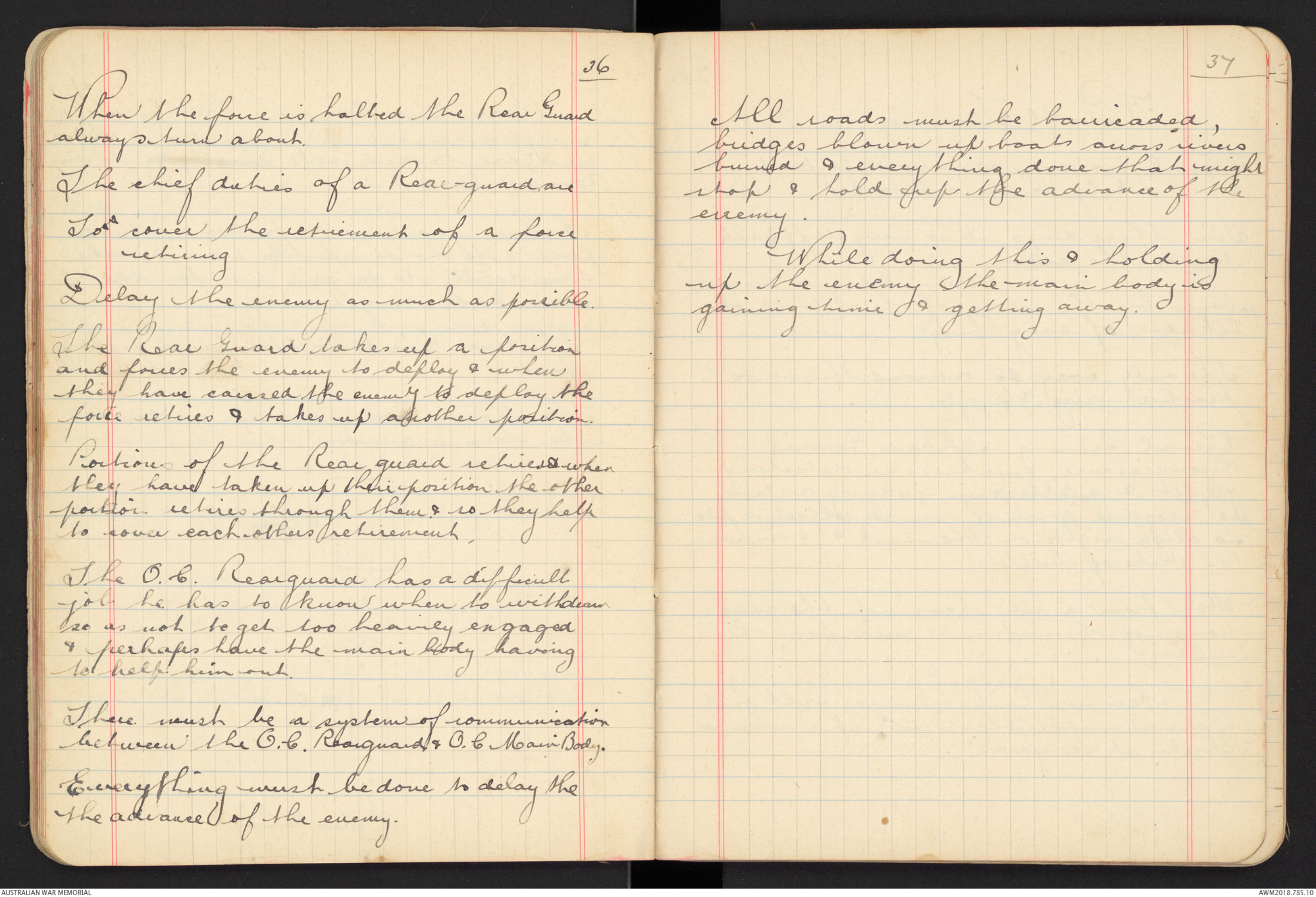
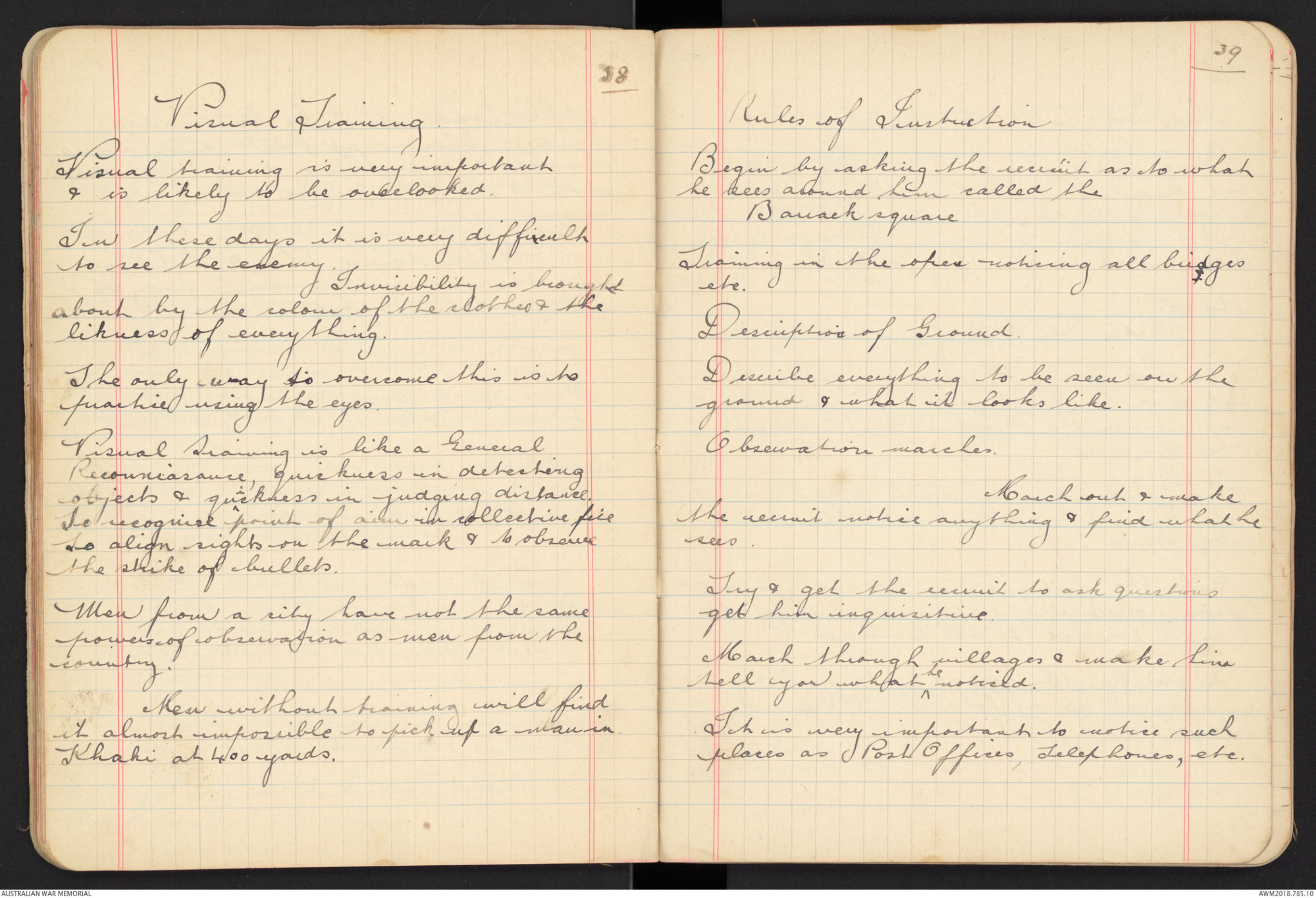

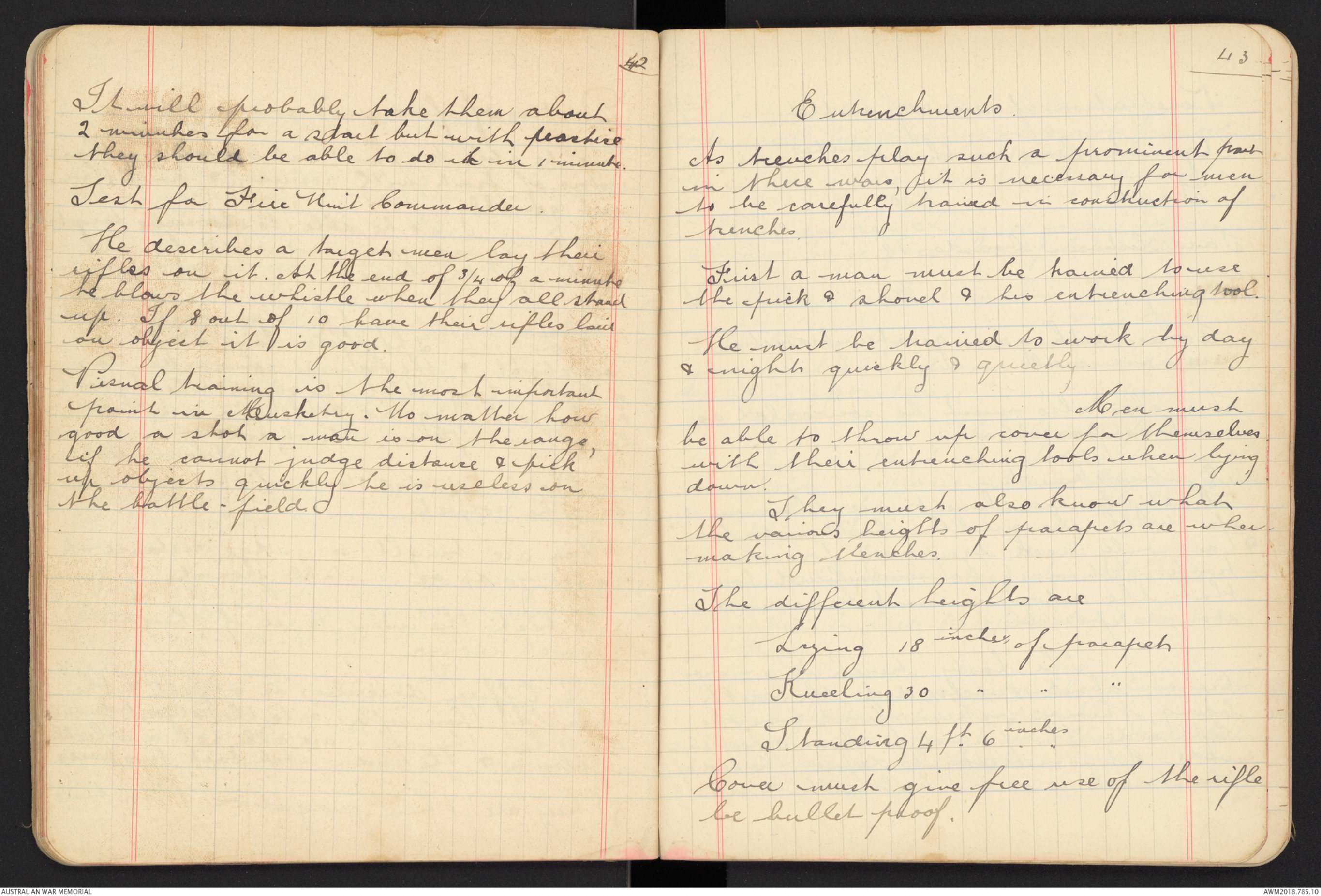
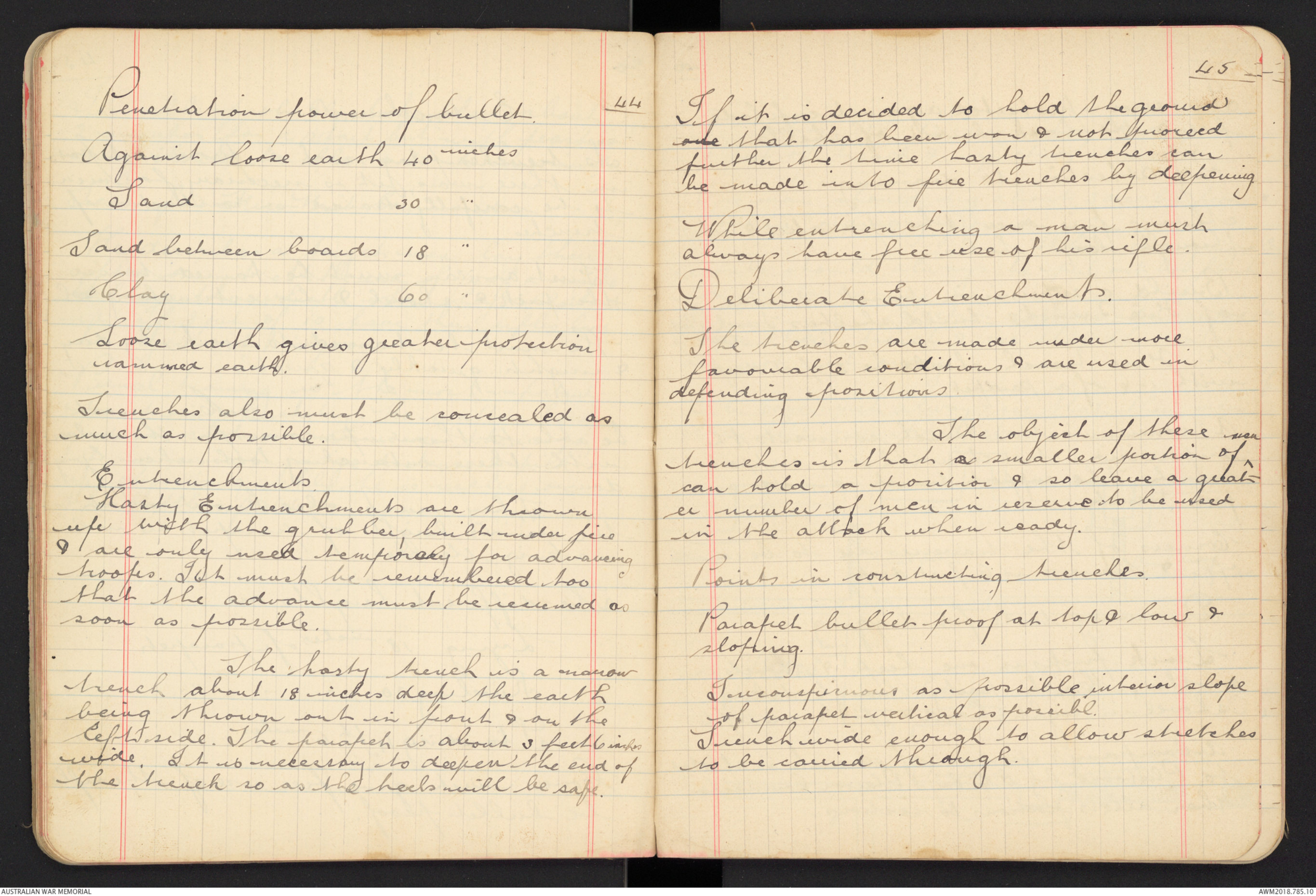
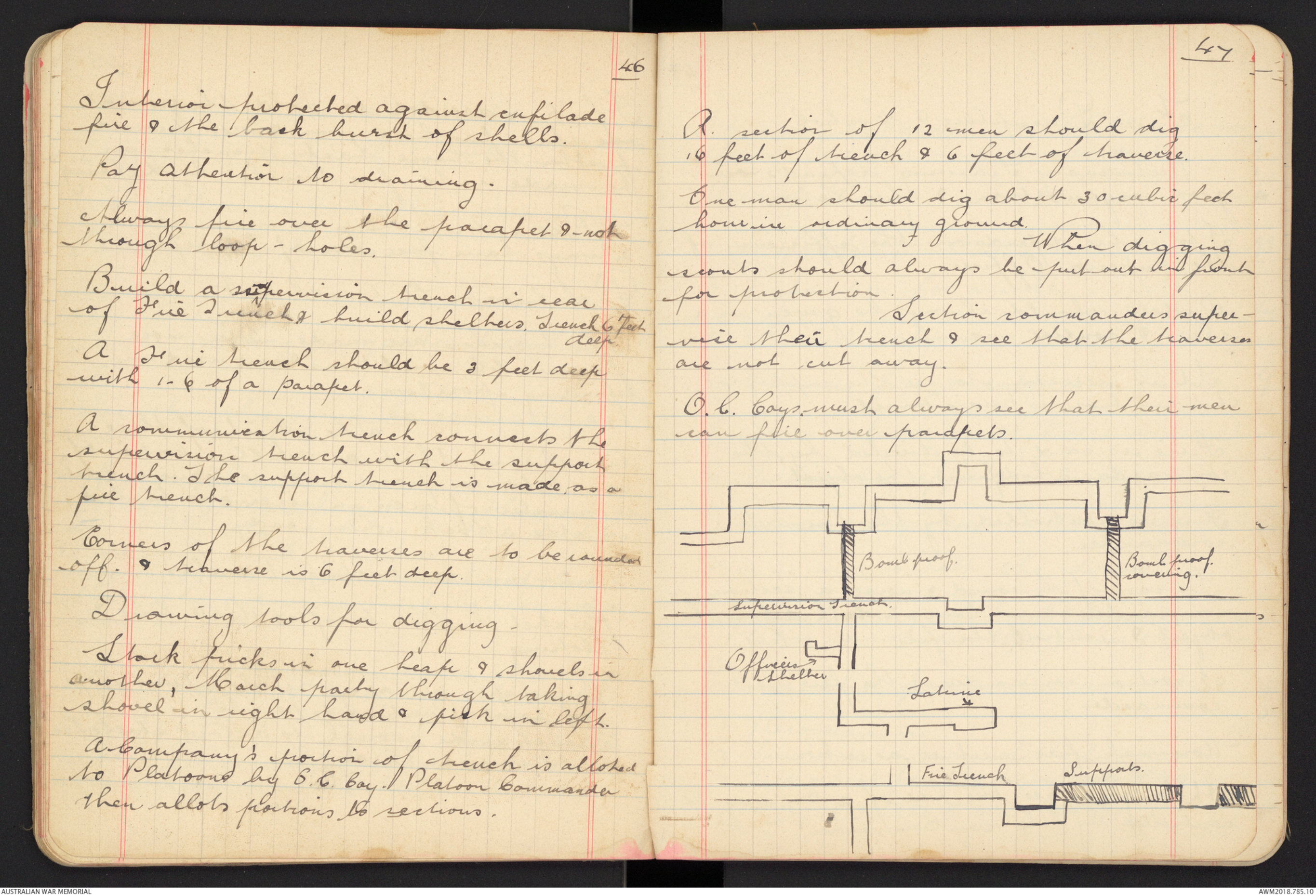
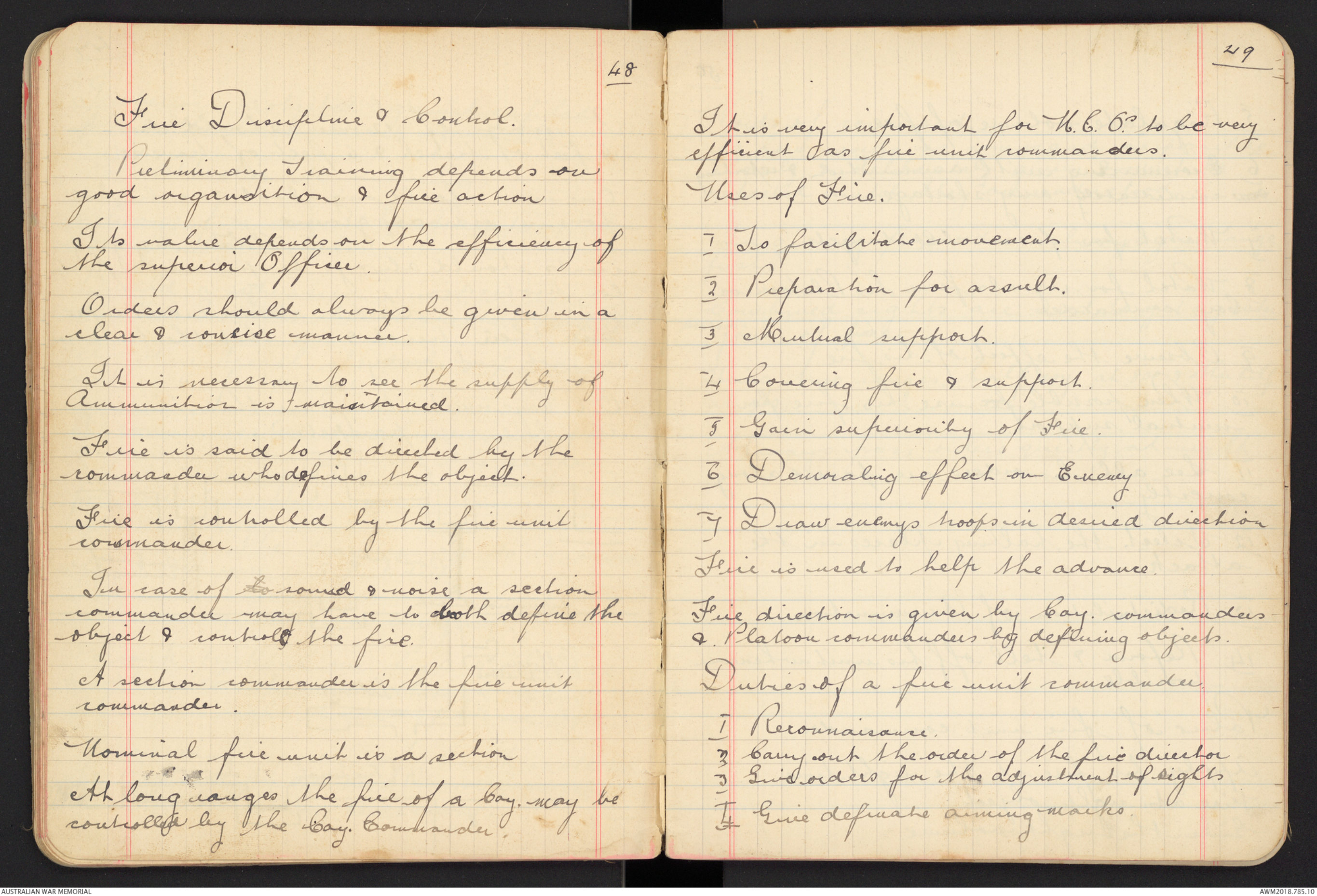
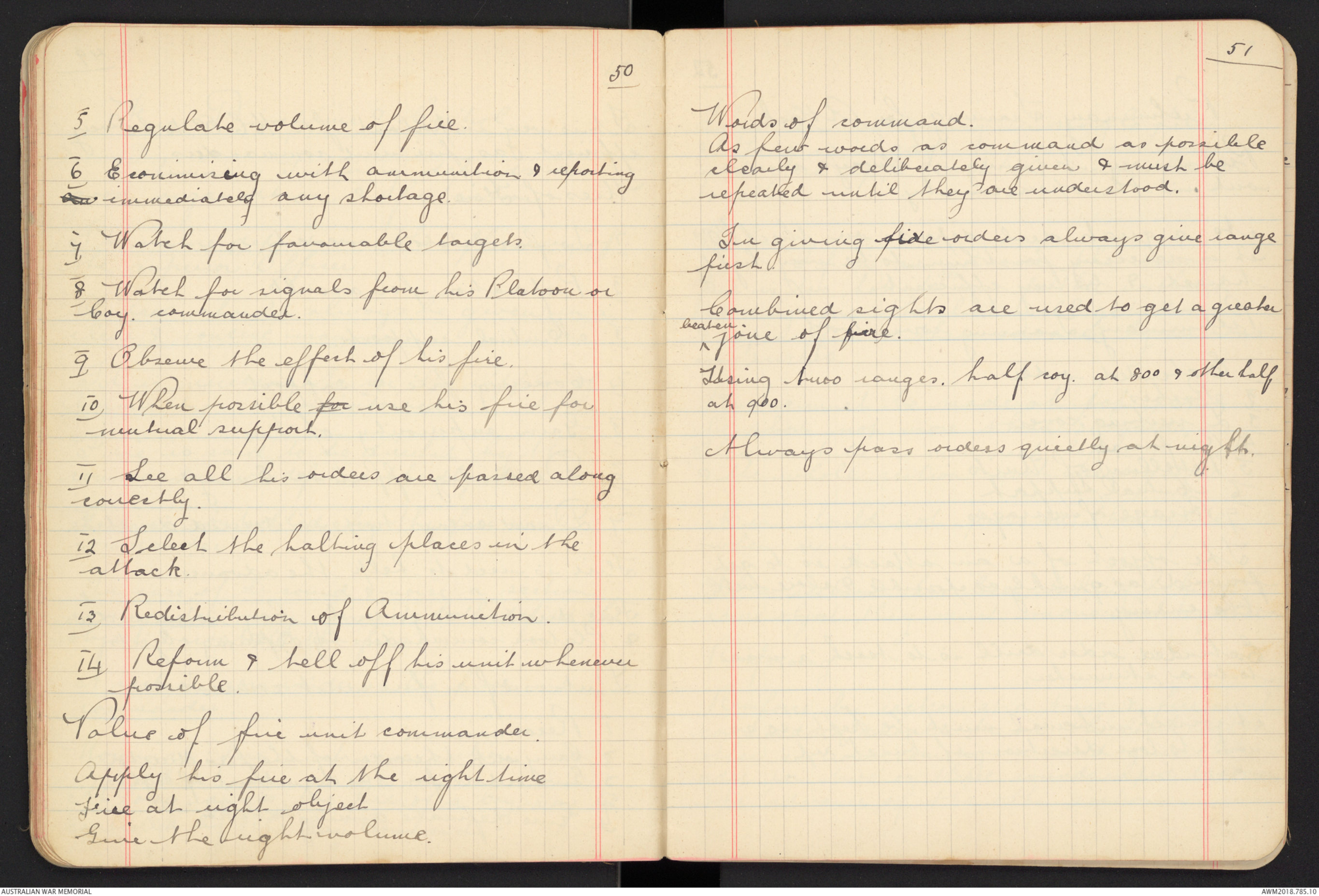
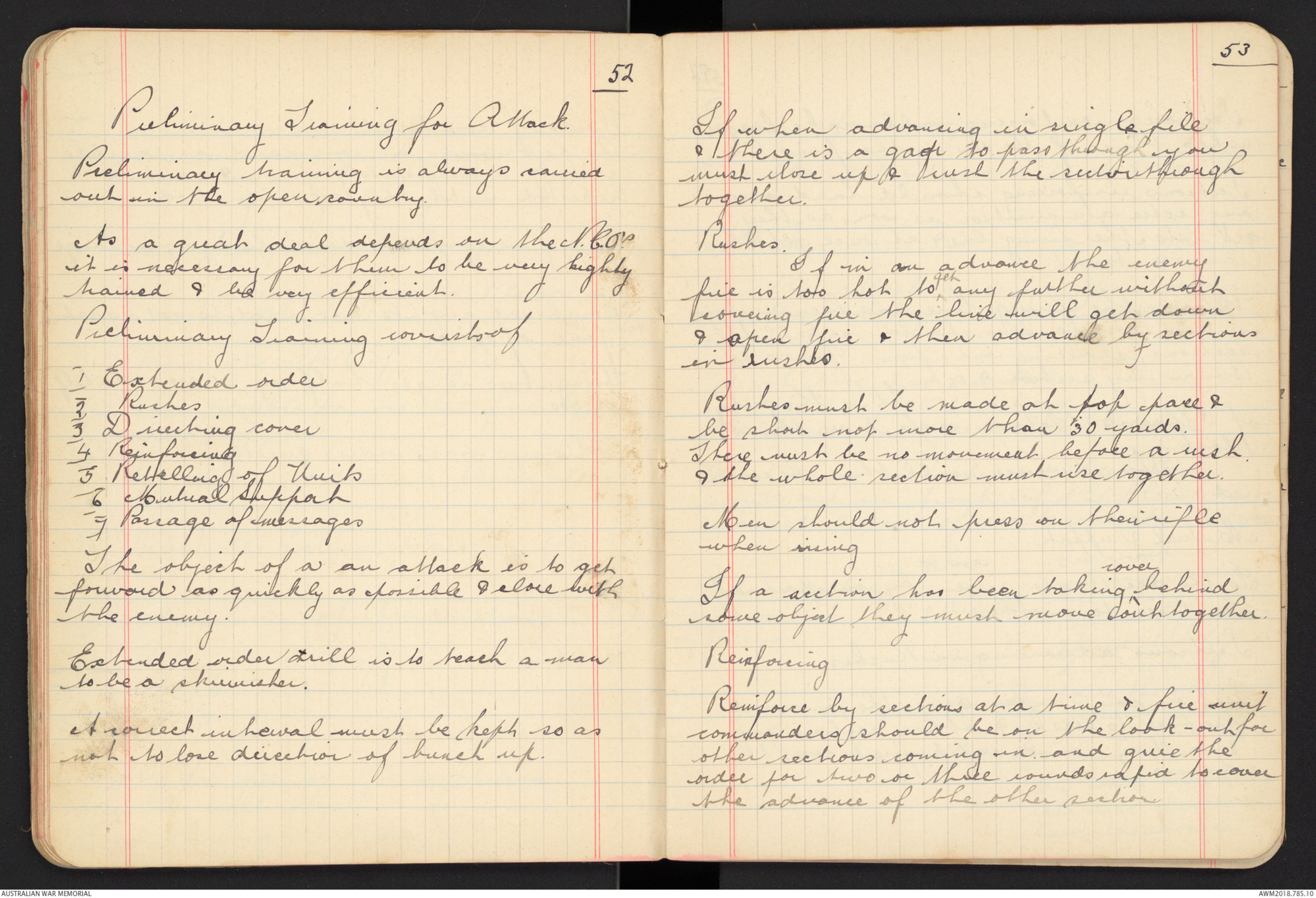
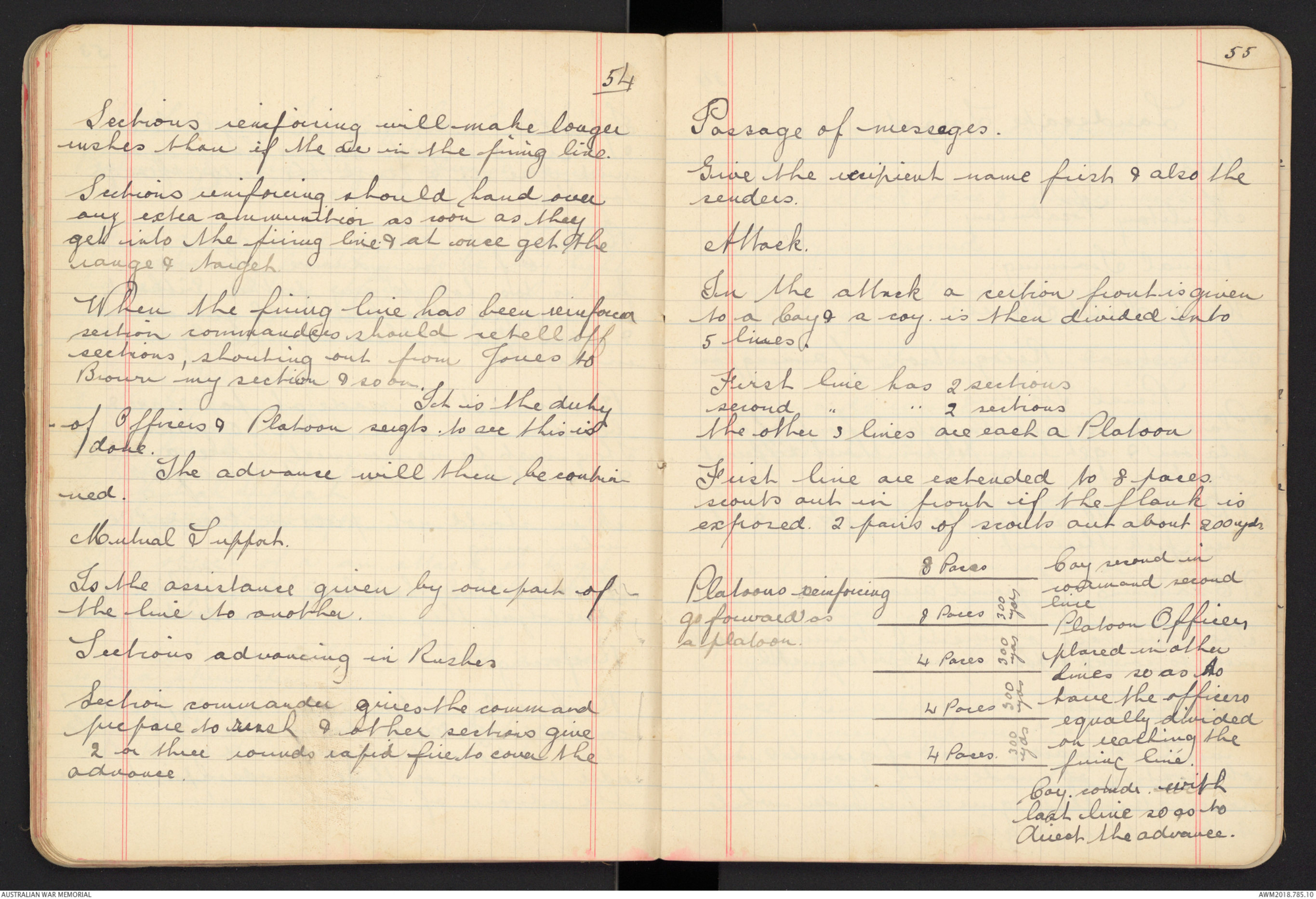
36
When the force is halted the Rear Guard
always turn about.
The chief duties of a Rear-guard are
To cover the retirement of a force
retiring
Delay the enemy as much as possible
The Rear Guard takes up a position
and forces the enemy to deploy & when
they have caused the enemy to deploy the
force retires & takes up another position.
Portions of the Rear guard retrieves when
they have taken up their position the other
portion retires through them. & s they help
to cover each others retirement.
The O.C. Rearguard has a difficult
job he has to know when to withdraw
so as not to get too heavily engaged
& perhaps have the main body having
to help him out.
There must be a system of communication
between the O.C Rearguard & O.C Main Body.
Everything must be done to delay the
the advance of the enemy.
37
All roads must be barricaded,
bridges blow up boats across rivers
burned & everything done that might
stop & hold up the advance of the
enemy.
While doing this & holding
up the enemy the main body is
gaining time to getting away.
38
Visual Training
Visual training is very important
& is like to be overlooked.
In these days it is very difficult
to see the enemy.
Invisibility is brought
about by the colour of the clothes & the
likness of everything.
The only way to overcome this is to
practice using the eyes.
Visual raining is like a General
Reconniassance, quickness in detecting
objects & quickness in judging distance.
To recognise point of aim in collective fire
to align sights on the mark & to obscure
the strike of bullets.
Men from a city have not the same
powers of observation as men from the
country.
Men without training will find
it almost impossible to pick up a man in
Khaki at 400 yards.
39
Rules of Instruction
Begin by asking the recruit as to what
he sees around him called the
Barrack square
Training in the open noticing all bridges
etc.
Descriptions of Ground
Describe everything to be seen on the
ground & what it looks like.
Observation marches.
March out & make
the recruit notice anything & find what he
sees.
Try & get the recruit to ask questions
get him inquisitive.
March through villages & make him
tell you what ^he noticed.
It is very important to notice such
places as Post Offices, Telephones, etc
40
Methods used in the open.
Place fatigue men in different positions
at know ranges place some in concealed
places. Then get the recruits to pick them
out & judge the distance. Always let them
know what ranges they really are.
Also
Use the Unit of measure system.
Take the range of some familiar object
such as a hundred yards & find out how
many times the object is contained in
the distance.
Place fatigue men with blank ammunition
get them to fire & pick out their positions
by sound.
Get the fatigue men to rush forward
from concealed positions so as to get the
eyes trained to the movements.
Describe the ground with military
words, such as a fold in the ground,
ridge, crest line etc.
41
Duties of fire unit commander.
To be able to point out objects within
sections of fronts with accuracy & point them
out quickly.
To be able to describe targets
so his squad can understand him and
pick up the target.
To find out if the men can pick up
the object. The officer lays a rifle on
an object & the fire unit commander has
a look along it at the object & then goes
back to his squad & the men in their
lay their rifle on the object.
The rifles
are then inspected to see if they are all
on the object.
Men are taught to judge distance up
to 600 yards on suitable ground.
To test the men to see if they are
quick enough.
The Officer describes an object & the
men lay their rifles onto the object described.
Where the rifles are all set a whistle
is blown & the men step back two paces.
They are then judged on their time.
42
It will probably taken them about
2 minutes for a start but with practice
they should be able to do it in 1 minute.
Test for Fire Unit Commander
He describes a target men lay their
rifles on it, at the end of 3/4 of a minute
he blows the whistle when they all stand
up. If 8 out of 10 have their rifles laid
on object it is good.
Visual training is the most important
practice in Musketry No matter how
good a shot a man is on the range,
if he cannot judge distance & pick
up objects quickly he is useless on
the battle field.
43
Entrenchments
As trenches play such a prominent part
in these wars, it is necessary for men
to be carefully trained in construction of
trenches.
First a man just be trained to use
the pick & shovel & his entrenching tool.
He must be trained to work by day
& nights quickly & quietly.
Men must
be able to throw up cover for themselves
with their entrenching tools when lying
down.
They must also know what
the various heights of parapets are when
making trenches.
The difficult heights are
Lying 18 inches of parapet
Kneeling 30 " " "
Standing 4 ft 6 inches " "
Cover must give free use of the rifle
be bullet proof.
44
Penetration power of bullet
Against loose earth 40 inches
Sand 30 "
Sand between boards 18 "
Clay 60 "
Loose earth give greater protection
rammed earth.
Trenches also must be concealed as
much a possible.
Entrenchments
Hasty Entrenchments are shown
up with the grubber, built under fire
& are only used temporarily for advancing
troops. It must be remembered too
that the advance must be resumed as
soon as possible.
The hasty trench is a narrow
trench about 18 inches deep the earth
being thrown out in front & on the
left side. The parapet is about 3 feet 6 inches
wide. It is necessary to deepen the end of
the trench so as the heads will be safe.
45
If it is decided to hold the ground
one that has been won & not proceed
further the time hasty trenches can
be made into fire trenches by deepening.
While entrenching a man must
always have free use of his rifle.
Deliberate Entrenchments.
The trenches are made under more
favourable conditions & are used in
defending positions.
The object of these
trenches is that a smaller portion of ^men
can hold a position & so leave a greater
number of men in reserve to be used
in the attack when ready.
Points in constructing trenches.
Parapet bullet proof at top & low &
sloping.
Inconspicuous as possible interior slope
of parapet vertical as possible.
Trench wide enough to allow stretchers
to be carried through.
46
Interior protected against enfilade
fire & the back burst of shells.
Pay attention to training.
Always fire over the parapet & not
through loop-holes.
Build a supervision trench in rear
of Fire Trench & build shelters. Trench 6 feet
deep.
A Fire trench should be 3 feet deep
with 1-6 of a parapet.
A communication trench connects the
supervision trench with the support
trench. The support trench is made as a
fire trench.
Corners of the traverses are to be rounded
off. & traverse is 6 feet deep.
Draining tools for digging.
Stack picks in one heap & shovels in
another, March party through taking
shovel in right hand & pick in left.
A Company's portion of trench is alloted
to Platoons by O.C.Coy. Platoon Commander
then allots portions to sections.
47
A. section of 12 men should dig
16 feet of trench & 6 feet of traverse.
One man should dig about 30 cubic feet
hone in ordinary ground.
When digging
scouts should always be just out in front
for protection.
Section commanders supervise
their trench & see that the traverses
are not cut away.
O.C. Coys must always see that their men
can fire over parapets.
[See hand drawn diagram]
48
Fire Discipline & Control
Preliminary Training depends on
good organisation & fire action
Its value depends on the efficiency of
the superior office.
Orders should always be given in a
clear & concise manner.
It is necessary to see the supply of
Ammunition is maintained.
Fire is said to be directed by the
commander who defines the object.
Fire is controlled by the fire unit
commander.
In case of do sound & noise a section
commander may have to both define the
object & control the fire.
A section commander is the fire unit
commander.
Nominal fire unit is a section
At long ranges the fire of a Coy. may be
controlled by the Coy. Commander.
49
It is very important for the N.C.O's to be very
efficient as fire unit commanders.
Uses of Fire.
- To facilitate movement
- Preparation for assault
- Mutual support.
- Covering fire & support.
- Gain superiority of Fire.
- Demoralizing effect on Enemy
- Draw enemys troops in desired direction
Fire is used to help the advance.
Fire direction is given by Coy. commanders
& Platoon commanders by defining objects.
Duties of a fire unit commander
- Reconnaissance.
- Carry out the order of the fire director
- Give orders for the adjustment of sights
- Give definite aiming marks.
50
5. Regulate volume of fire.
6. Econimizing with ammunition & reporting
our immediately any shortage.
7. Watch for favourable targets.
8. Watch for signals from his Platoon or
Coy. commander.
9. Observe the effect of his fire.
10. When possible for use his fire for
mutual support.
11. See all his orders are passed along
correctly.
12. Select the halting places in the
attack.
13. Redistribution of Ammunition.
14. Reform & tell off his unit whenever
possible.
Value of fire unit commander.
Apply his fire at the right time
Fire at right object
Give the right volume.
51
Words of command.
As few words as command as possible
clearly & deliberately given & must be
repeated until they are understood.
In giving fire orders always give range
first.
Combined sights are used to get a greater
^beaten. zone of fire.
Using two ranges. half coy. at 800 & other half
at 900.
Always pass orders quietly at nights.
52
Preliminary Training for Attack.
Preliminary training is always carried
out in the open country.
As a great deal depends on the N.C.O's
it is necessary for them to be very highly
trained & be very efficient.
Preliminary Training consists of
- Extended order
- Rushes
- Directing cover
- Reinforcing
- Retelling of Units
- Mutual Support
- Passage of messages
The object of an attack is to get
forward as quickly as possible & close with
the enemy.
Extended order drill is to teach a man
to be a skirmisher.
A correct interval must be kept so
as not to lose direction of bunch up.
53
If when advancing in single file
& there is a gap to pass through you
must close up & rush the section through
together.
Rushes.
If in an advance the enemy
fire is too hot to ^get any further without
covering fire the line will get down
& open fire & then advance by sections
in rushes.
Rushes must be made at top pace &
be short not more than 30 yards.
There must be no movement before a rush.
& the whole section must rise together.
Men should not press on their rifle
when rising.
If a section has been taking ^cover behind
some object they must move out together.
Reinforcing
Reinforce by sections at a time & fire unit
commanders should be on the look-out for
other sections coming in and give the
order for two or three rounds rapid to cover
the advance of the other section.
54
Sections reinforcing will make longer
rushes than if the are in the firing line.
Sections reinforcing should hand over
any extra ammunition as soon as they
get into the firing line & at once get the
range & target.
When the firing line has been reinforced
section commanders should retell off
sections, shouting out from Jones to
Brown my section & so on.
It is the duty
of Officers & Platoon sergts. to are this is
done.
The advance will then be continued.
Mutual Support
To the assistance given by one part of
the line to another.
Sections advancing in Rushes
Section commander gives the command
prepare to rush & other sections give
2 or three rounds rapid fire to cover the
advance.
55
Passage of messages.
Give the recipient name first & also the
senders.
Attack.
In the attack a section front is given
to a Coy & a coy. is then divided into
5 lines.
First line has 2 sections
second " " 2 sections
the other 3 lines are each a Platoon
First line are extended to 8 paces.
scouts out in front if the flank is
exposed. 2 pairs of scouts out about 200 yds.
|
Platoons reinforcing go forward as a platoon |
8 paces |
Cpy second in command second line |
|
8 paces 300 yds |
Platoon Officers placed in other lines so as to |
|
|
4 paces 300 yds |
have officers equally divided on |
|
|
4 paces 300 yds |
reaching the firing line |
|
|
4 paces 300yd |
Coy. comdr. with last line so go to direct the advance. |
Platoons reinforcing 8 Paces Coy second in
go forward as Coy command second
line
command second
line.
a platoon.
Coy second in
command second
line.
Platoon Officers
placed in other
lines so as to
have the officers
equally divided
on reaching the
firing line.
Coy comds. with
last line to go to
direct the advance.
 Sandy Mudie
Sandy MudieThis transcription item is now locked to you for editing. To release the lock either Save your changes or Cancel.
This lock will be automatically released after 60 minutes of inactivity.